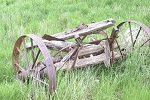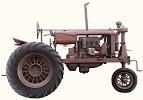


 |
 |  |
Corn is mostly starch, which results in a lot of fat being produced. Cattle did not evolve on starch; they evolved on cellulose. Cattle have special stomachs called rumens, which contain bacteria for breaking down cellulose. Corn is low in protein, and therefore, soybean meal is added to feed with corn for protein. Soybean meal is left over from extraction of oil for cooking. The advantages of feeding alfalfa instead of corn and soybean meal:
Very little labor is required for growing alfalfa, while corn and soybeans require so much labor that GMOs for corn and soybeans are used as a labor saving tool. GMOs would not exist for corn and soybeans except for labor saving. Without GMOs, corn and soybeans require surface cultivation three times per season to kill weeds and break up the crust, while GMOs allow spraying without cultivation. A lot of chemicals are required for both corn and soybeans because of their slow growth. Then GMOs are a chemical substitute for tillage, which adds to the need for chemicals. The chemicals are expensive to apply and bad for the health of workers and consumers. Large dairy farmers who have confined herds often feed alfalfa, which is usually shipped to them as large bales, and then it is chopped. But feeder cattle are fed corn because of ancient concepts that fat is needed to make meat juicy and tender. Leaner meat would be better for health. Alfalfa has plenty of protein and allows a small amount of oats to be added. Oats combines well with alfalfa; and it doesn't need to be chopped, though it can be. But since oats is low in protein, a lot of oats would result in protein deficiency, which would reduce the health of the calves and slow weight gain. Growing oats organically is very easy, because of its rapid growth. In the upper plains, oats is harvested before grasshoppers get large enough to damage it. So organic oats can easily be added to alfalfa for organic beef. Most types of feed, such as corn and grass, are too low in protein without protein supplements. Grazing on grass gets the protein level up by increased volume in a more palatable form. Feeding cattle alfalfa extends growing time compared to feeding corn. Feeding duration will typically be extended from the eight months minimally required on corn to twelve months or more on alfalfa. Feedlots For Cattle Cattle feedlots should be on flat ground, so runoff doesn't go into waterways. There should be slight elevation around the feed troughs and then slight taper outward.
Manure should then be scraped up and spread out for drying. When it is cow manure without chemicals, it could be sold dry for gardeners who love dry cow manure for conditioning their soil. If the manure is not sold, it can be spread on farm ground before it is completely dry. Feeding Minerals Producers need to be adding minerals to their feed, if not vitamins also. Alfalfa is high in vitamins, but oats is not. No plant-based feeds are high in all minerals. Zinc and copper are negligible in most vegetation. Vegetarian animals have a shortage of zinc and copper, and they are sometimes seen eating soil for this reason. Cobalt might be a similar problem. These minerals are toxic and not easy to use, so large quantities must be avoided. Cultivating Alfalfa The ground gets quite hard with alfalfa due to driving over it constantly. A possible improvement would be to partially chisel the ground after the last cutting in the fall while leaving space between the grooves, so some of the alfalfa remains undamaged. Regrowth in the spring would then be rapid.
The grooves should fill in rapidly with new growth in the spring. This type of partial chiselling would be like replanting the alfalfa each year with rapid growth in the spring. This result might eliminate the need to replant the alfalfa when it gets old. Chiselling would not have to go as deep for alfalfa as it does for grains, since alfalfa is growing constantly with deeper roots than grains have. But the chisel shanks need to be redesigned. A lot of curvature produces an uplifting motion causing large chunks to form, which will damage nearby plants. So the curvature needs to be minimized to reduce the size of lumps. But even then, one deep cut will produce large lumps, depending upon the amount of moisture in the ground. So two shanks in a row would be an improvement. The first shank could go 8-10 inches deep, and the second one, 12 or more inches deep.
Cutting roots under the ground might be a good way to build up organic matter under the ground, if there is enough oxygen for decay. It's not easy to get oxygen under the ground, as microbes use it up rapidly. Alfalfa moves water into and out of the ground faster than usual, which carries oxygen along with the water and might facilitate oxygen flow-through with chiselling. Subverting The Meaning Of Organic Some activists are concerned about confinement of livestock. There are wrong ways to go about confinement, but proper confinement is suitable for feeding livestock including cattle. There is nowhere near enough space for grazing feeder cattle. Grazing requires very low animal density, because hooves do a lot of damage to the ground and vegetation. Grazing is good for calf production on the prairies, where there is a lot of space, but unrealistic for feeding. Calves are weaned at about four months old and then fed for a minimum of an additional eight months. Weaned calves are shipped from the grasslands of South Dakota to feed lots in Iowa and Illinois in large numbers. Organic should not be relevant to cows which produce calves for feeding. When greens try to say, you have to treat your cows and pre-weaned calves nice to be organic, it might make good moral philosophy but has nothing to do with the purpose of organic food. Humane treatment of animals applies the same to nonorganic and organic. To require grazing with organic beef production only guarantees that very little organic beef can be produced. Organic should be the norm, not an elaborate extravaganza. About one tenth as much land space would be required to feed organic alfalfa compared to corn and soybeans. The muddle on this subject indicates that stock cows must be organic if beef is organic, but I haven't studied the laws on organic. Nothing could be more ridiculous than requiring stock cows to be organic. Such meddling prevents organic from being developed as it should. It points to mindless greens and idiot bureaucrats overwhelming the subject. It takes a minimum of eight months of feeding after calves are weaned. What happened eight months earlier is not relevant to organic under normal conditions. Some pesticides could be stored in fat, but weaned calves are not fattened. Demanding a defined history for cows is way too complex. It reduces organic beef to a few 1%ers instead of something the public could benefit from. What such over-reactions show is that producers should develop their own standards for practicality and sell under different labels than organic, which would make improved food available to more people. Labels such as "improved" and "chemical free" could be used making de facto organic much more available to the public.
|
||||||||||||||||
 |
 |
 |